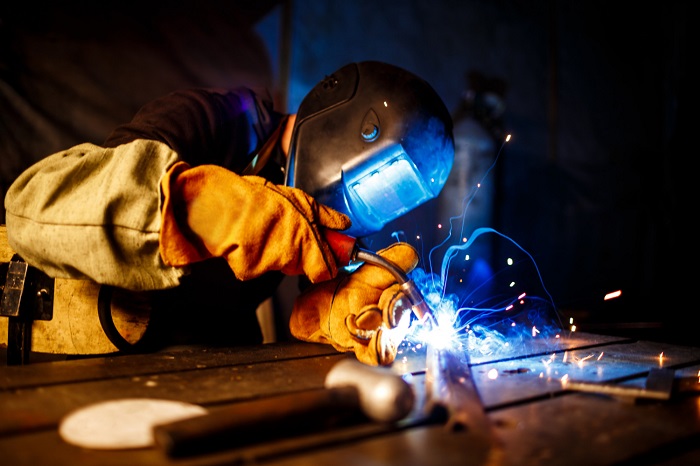Welding produces dangerous fumes that can cause long-term health issues if inhaled regularly. That’s why using a proper welding fume extractor is critical for keeping workshops safe. This guide will explain what welding fumes consist of, the importance of fume extractors, what to look for when buying one, and frequently asked questions about their use.
What Are Welding Fumes?
Welding fumes contain tiny particles and gases that come from the filler metals and materials being welded. The most common fumes from welding include iron oxide, manganese, chromium, nickel, silica, fluorides, and zinc oxides.
Exposure to welding fumes can lead to metal fume fever, eye or lung irritation, reduced lung function, asthma, pneumonia, bronchitis, siderosis, infertility issues, kidney damage, neurological issues, and an increased risk of lung cancer. The particles can stick in the lungs for months or years before the body clears them.
Why Use a Welding Fume Extractor?
A welding fume extractor removes the dangerous particles from the air before they can be inhaled. They have an industrial-strength fan and filter system designed specifically for welding fume capture and filtration. Quality extractors filter particles down below 0.5 microns to capture even ultrafine particles.
Without proper extraction, welding fumes will linger in the air of workshops for hours, settling on surfaces and being re-suspended later. An extractor correctly positions the suction near the arc or flame to effectively remove particles before they disperse.
What to Look for When Purchasing an Extractor
When investing in a welding fume extractor, key features to look for include:
- High suction flow rate (150-250+ CFM)
- Durable construction for shop use
- Flexible arm to position near work
- Cleanable or replaceable filter
- Automatic or intelligent sensors
- Portability with locking wheels
- Warranty period
High-end extractors have built-in sensors that automatically adjust the fan speed based on arc detection to conserve energy and filter life. Look for quality brands like Plymovent, Clean Air, or UAS that are made to withstand years of shop use.
Getting the Proper Extractor for Your Needs
Choosing the right size and type of welding fume extractor depends on your specific welding processes and workspace. Keep these factors in mind:
- Type of welding – MIG, TIG, stick, flux-cored
- Needed capture zone and arm length
- Portability requirements
- Workspace shape and size
- Single or multi-user set-up
- Weld fume contaminants and filter type
Buying a larger machine than you need is better than undersizing and having poor fume capture. Many filters can also be upgraded to handle harsher contaminants like chromium or galvanized welding.
Improving Workshop Ventilation
While fume extractors capture particles directly at the weld point, overall shop ventilation is still important for air quality. Here are some ventilation tips:
- Use exhaust fans to actively vent out stale air
- Open doors or large bay doors when possible
- Position equipment away from worker breathing zones
- Take regular breaks from the workshop area
Even with a quality welding fume extractor, be sure to wear an appropriate respirator whenever welding or working near welding in progress. Stay upwind of the fume plume and avoid breathing in visible smoke.
Innovative Welding Fume Extractors by Transals
A recently introduced product that aims to revolutionize welding fume extraction is the Translas line of torches and extractors. Translas is a Dutch manufacturer of welding equipments and accessories that has developed patented built-in fume extraction torches. Their torches capture fumes directly at the welding tip, achieving up to 98% fume extraction efficiency according to internal testing. This method pulls the dangerous particles away before the operator can inhale them rather than trying to chase them around the workspace with external arms. The welding fume extractor torches connect to standalone mobile filter units that clean and recirculate the air. Translas touts these integrated extractor torches and filters as the future of safer and more productive welding fume capture. They offer different torch heads for MIG, TIG, and stick welding.
FAQ About Welding Fume Extractors
New welder hobbyists or small fabrication shops often have questions about selecting and using welding fume extractors correctly. Here are answers to some frequently asked questions:
Q: How close should the extractor be to the welding?
A: The extraction arm should be positioned 2-3 inches away from the arc/flame and following alongside the weld seam. Adjust if necessary based on fume capture performance.
Q: How do I know if the extractor is powerful enough?
A: You should not see large plumes of fume escaping the capture zone in normal operation. There should be adequate visible airflow pulling fumes into the nozzle.
Q: How often do filters need to be changed?
A: Filter change frequency depends on use but expect every 3-12 months. Check pressure gauges and change if airflow becomes limited. Dispose of used filters properly.
Q: Can I vent the extractor exhaust back into my shop?
A: No, extracted air must be vented fully outside to remove contaminants. Re-circulating filtered air will still lower workshop air quality over time.
Q: Should I look for special filters for stainless or galvanized welding?
A: Yes, upgraded filters improve capture on ultrafine particles from exotic materials. But they cost more and reduce airflow.
Q: Can I use my extractor outdoors?
A: Most models are rated for indoor use only due to airflow requirements, filter contamination risks, and internal electronics that cannot get wet.
Stay Safe!
Using a proper welding fume extractor is critical to keeping fabrication and metalworking shops healthy and compliant. Breathing welding fumes day after day can accumulate real health risks over a career. Protect yourself and your crew with an effective filtration unit sized appropriately for your workspace.

